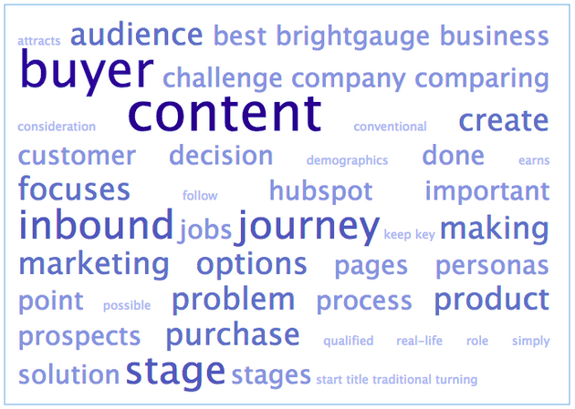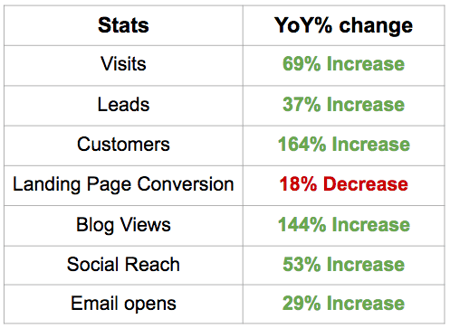The Power of Inbound Marketing

Unless you live under a rock, you’ve probably heard by now that sales and marketing processes are changing. People don’t want to be sold to anymore, instead they want to make informed buying decisions based on their own research from sources they feel are trustworthy.
Almost 2 years ago, I started doing some research of my own when it came to marketing. I was working for a company that still focused on the old sales team approach, relying heavily on cold calls while crossing fingers and hoping that someone on the other end of the line would give them the time of day - “smiling and dialing” as we called it. Long story short, I knew how I handled those same types of cold calls from vendors when I received them and I couldn’t believe that any modern company still put most of their faith in this type of system. I decided that I needed to focus on fresh marketing ideas and a company that could ‘see the light’ so to speak, so I set my focus on the Inbound Marketing movement and never looked back. My first focus was getting Inbound Certified, an online course offered by HubSpot, one of the world’s most well-known marketing automation platforms.
Inbound Evangelist
I’ve learned so much in these last 2 years, and most importantly I’ve had a lot of fun doing it! With the Certification under my belt and also some freelance work experience focusing on content creation, I set out to find a company that valued the inbound methodology. Since joining the BrightGauge team 6 months ago (where we only focus on HubSpot’s inbound methodology), I’ve also completed my HubSpot Certification, started attending local events for the Tech community, and in general spent time explaining what my job is and why I love it to anyone willing to listen. So when I was recently invited to speak at an Inbound Marketing workshop in Miami, I was eager to help teach others about how inbound works and the results we see at BrightGauge. The feedback was great from the workshop attendees and with my new mission to help others who are curious about inbound, I decided to recap my presentation here.
speaking at the Rebound with Inbound content marketing workshop at City Tech Miami
What is Inbound?
Put simply, inbound marketing focuses on producing and distributing valuable content that earns the attention of qualified prospects. It attracts those prospects to your business and keeps them coming back for more information while they are considering their options before ultimately making a purchase - i.e. the process of turning strangers into customers. I should also point out here that inbound can work for any type of company - whether you’re a B2B or B2C (or even a charitable organization). The key is to create quality content that focuses on the challenge your customers face and how your solution can play a role in resolving that challenge, instead of content based solely on your product features.
Getting Started with Content
At this point, your next question is probably something along the lines of But how do I really know what content to create? or you may be unsure about translating a product/service into the solution it provides… I’m just trying to sell ABC product, not fix their problems…
According to HubSpot, the inbound methodology is built on the foundation of The Buyer’s Journey, a process of the 3 different stages that a buyer goes through when comparing their options before finally making a purchase:
- Awareness Stage: the buyer becomes aware of the problem at hand
- Consideration Stage: the buyer is focused on comparing all possible solutions for the problem identified
- Decision stage: the buyer is making a short list of options to consider for a purchase decision
It’s important to note here that BrightGauge has been practicing inbound marketing for 3 years and we’re still evolving our content to meet buyers in all stages of the Journey, and do so at the right time in their individual journey.
As you’re working on your content, another important factor to keep in mind is your audience. In a B2B environment, traditional (outbound) marketing would dictate that you use conventional attributes such as company size, job title, revenue, etc. as you are framing your audience. But inbound focuses on Buyer Personas to help you create the right content for your audience. HubSpot explains Buyer Personas as “semi-fictional representations of your ideal customer that include demographics, behavior patterns, motivations and goals.” Although at BrightGauge, we take it a step further and also do our best to follow the Jobs To Be Done framework, which tells you to focus on the problem your buyer is trying to solve by asking yourself what is the customer “hiring” us for? (check out this video featuring Harvard Business School’s Clay Christensen with a real-life example of Jobs To Be Done).
Once you have content being produced regularly, don’t forget to share it! Of course a blog is the most obvious place to start, but don’t forget about website pages, landing pages, social media, calls to action and emails! You can always go back and reference The Buyer’s Journey for a closer look at what types of content are suited best for each stage.
In Real Life: Results with Inbound
You’ve read this far and hopefully most of you are on board with the inbound methodology because you understand the evolution of buying and selling in today’s world. But somewhere out there, I know there’s still a nay-sayer who just doesn’t get it. I know your type too well… so let’s get down to the heart of the matter and talk about the real results we’ve seen at BrightGauge.
As reported by HubSpot, within the first year of adopting the inbound methodology, BrightGauge increased our customer count by 87%, at the same time that we increased revenue by 152%, and even managed to decrease our monthly attrition rate by 55%. Those are pretty incredible numbers but let’s also look at some of our most recent stats, comparing August 2014 to August 2015:
As you can see, I’m not promoting inbound only because I’m partial to BrightGauge... these are facts from our data and proves that the methodology provides incredible results for a one-year period! And what about the big, red font showing a decrease in landing page conversions? That drop is to be somewhat expected, based on the significantly higher volume of visits to our site - but of course it also gives us something to focus on improving even more in the near future. These days, BrightGauge is thrilled to report that we have over 4,000 users found in 750+ cities across 5 continents… and we’re still growing (Inbound works)!
Getting started with Inbound
I know it can seem like an overwhelming task to launch a completely new marketing strategy, but it’s ok to start small. When BrightGauge first got started with inbound, they focused on 1 - 2 blog posts per week, some social posting and a couple of landing pages. Our founders, Brian and Eric Dosal, realized that something was working, but they weren’t sure exactly what. That’s where I came in! These days, we’re blogging 3 times every week, with a heavy focus on social sharing, we host a free educational (non-sales pitch) webinar once a month, emails are sent regularly based on list segmentations, we have several free white papers, webinars and eBooks on our website, and we also recently launched a podcast. So, we’re constantly producing fresh content, tracking our results (we’re a data company, after all), and being patient - it takes people time to turn into customers.
My last piece of advice, as told to the audience at that workshop? Put the people first. Meaning that, yes, marketing is a numbers game and there are always statistics to analyze… but if you focus on creating valuable content that helps your audience learn or make informed decisions, and produce that content on a regular basis then you’ll see success in inbound. And remember, Inbound marketing is a marathon, not a sprint!
A few free resources if you’re just getting started:
These are by no means the only awesome, free resources out there, but I’ve used these before and found them to work well…
MailChimp: an email marketing solution that’s free for up to 2,000 subscribers
Google Analytics: for insights on how visitors find and use your site
HootSuite: a social media management dashboard, free for up to 3 platforms
Canva: a web-based graphic design tool
And don’t forget to subscribe to the HubSpot blog, they offer fantastic insights to help you continually improve your inbound strategies!
Have a question, suggestion, or want to chat about inbound marketing? I can be reached at amccluney [at] brightgauge [dot] com or follow me at @AjMcCluney
Free MSA Template
Whether you’re planning your first managed services agreement, or you’re ready to overhaul your existing version, we've got you covered!





